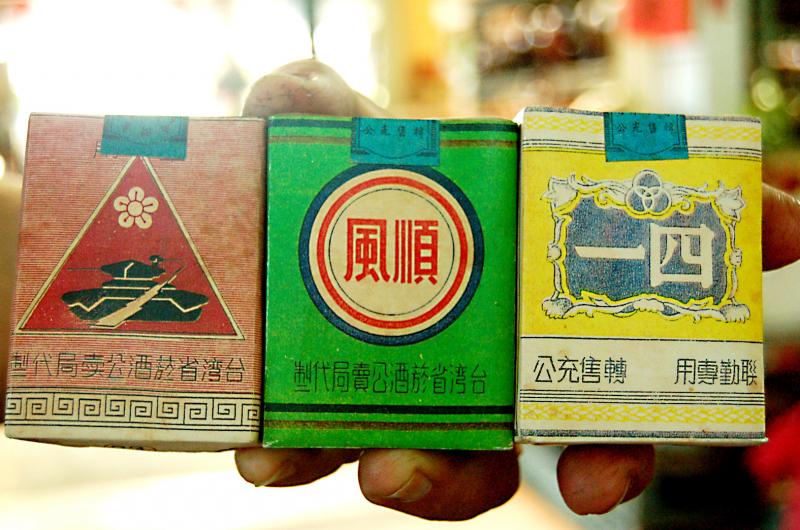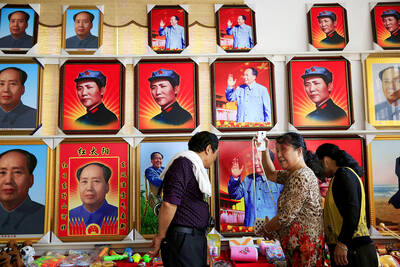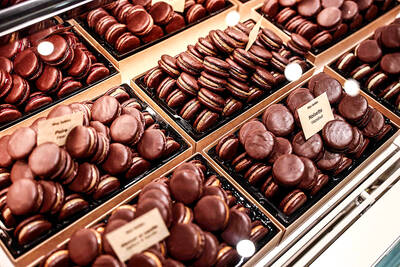MAY 18 to MAY 24
If you wanted a smoke in 1947, you would likely choose “Bananas,” the filterless, state-produced cigarette that made up for 86 percent of total sales that year. Or you might hit up one of the ubiquitous contraband vendors and pray not to be caught by the armed Taiwan Tobacco and Liquor Monopoly Bureau (TTL) agents.
These are the agents whose mistreatment of a Taiwanese elderly lady suspected of selling illegal cigarettes triggered the 228 Incident, an anti-government uprising that was violently suppressed. Their Japanese predecessors seemed to be even more brutal. In September 1930, agents interrogated over 100 villagers living in Hsinchu County’s Hukou Township (湖口) after hearing rumors of illegal distilling. The torture was so harsh that even the local police reportedly tried to interfere.

Photo : Photo: Chen Hsin-jen, Taipei Times
Under pressure to generate revenue from their new colony, the Japanese first monopolized opium, camphor and salt before turning to tobacco in 1905 and liquor in 1922. Arriving in 1945, the Chinese Nationalist Party (KMT) continued the policy over both items through the TTL, which was reorganized in May 1947. They renamed all the products to eradicate any trace of Japanese influence (Banana was originally named Akebono), and kept private production illegal until 2002.
COLONIAL FINANCES
Taiwan was mostly an agrarian society when the Japanese arrived in 1895. The colonial forces encountered way more resistance than they had expected, and Taiwan’s economy fell into a slump as revolts continued to flare up. Many Japanese politicians started questioning the financial value of owning Taiwan; one Diet member suggested selling Taiwan to France for $100 million yen.

Photo: Chang Jui-chen, Taipei Times
With no means of generating revenue outside of agriculture, the Japanese decided on the state-monopoly system, which Tadao Yanaihara writes in Taiwan Under Imperialism “is typical for colonies and boosted Taiwan’s economic independence in many ways.”
The first monopolized industry in Taiwan was opium. It was widely consumed when the Japanese arrived, and officials debated between gradually eradicating the habit or banning it outright. The former camp prevailed, and the state took control of the industry in 1897.
Salt and camphor followed, and the government set up a monopoly bureau to manage the three industries. After adding tobacco and liquor, the monopoly became extremely lucrative, averaging about 40 percent of the colony’s total revenue for the next two decades.

Photo courtesy of Wikimedia Commons
Tobacco had been grown in Taiwan at least since the 1600s. Initially, the Japanese tried to impose heavy taxes on tobacco farmers, but that only led to a sharp decline in the industry — so they ended up monopolizing the trade as well. There wasn’t much of a liquor industry to speak of when the Japanese arrived, as alcoholic beverages were seen as one of many community-based agricultural products. Still seeking revenue streams, the colonial authorities began taxing liquor producers in 1907. They then overhauled the entire business for mass market production and provided needed infrastructure and training.
Feeling the effects of the post-World War I depression, the authorities in 1922 nationalized the liquor industry, shutting down over 200 businesses and banning private brewing. Licenses for distributors and vendors were extremely valuable, and corruption was reportedly rife as merchants vied for the privilege. Most of them lived under the thumb of the monopoly bureau, who could use all sorts of excuses to revoke their licenses.
The colony’s liquor-producing facilities were badly damaged by Allied airstrikes across Taiwan during World War II, and production dropped dramatically before Japan’s defeat in August 1945.

Photo courtesy of Wikimedia Commons
CONTINUING OLD WAYS
The KMT continued the state monopoly on tobacco and liquor shortly after its arrival in 1945. It was declared during a 1946 Taiwan Provincial Assembly meeting that the state should keep the monopoly to maintain the economy.
“The new government had yet to find an alternate source of income, so it decided against abolishing the monopoly to avoid disrupting Taiwan’s economic stability and development,” a monopoly bureau annal states.
Of course, the KMT also needed funds to fight the Chinese Civil War and later to support the influx of refugees from China after 1949. Since opium was illegal under the KMT and salt was managed by another agency, the monopoly bureau was left with tobacco, alcohol, matches, measurement weights and camphor.
In May 1947, the bureau took on the name Taiwan Tobacco and Liquor Monopoly Bureau after dropping the matches and weights. They changed the Chinese name from zhuanmaiju (專賣局) to gongmaiju (公賣局), both of which mean monopoly bureau but the officials thought the latter term was “softer” and would ease public resentment.
Illegal activity continued to plague the venture until March 1950, when the Taiwan Garrison Command established task forces in Taipei, Taichung and Kaoshiung to clamp down on the contraband market.
The government took over the 12 breweries and distilleries the Japanese left behind, but only two had escaped the war unscathed. They reactivated what they could and started with the same products that the Japanese made, rebranding them to erase the Japanese influence. Takasago Beer, for example, was renamed Taiwan Beer, but it didn’t acquire its current flavor until Taiwanese ponlai rice was added to the brew in the 1960s.
Only when the economy stabilized did the TTL start diversifying into items like rice liquors and shaoxing wine. Things started slowly with quite a few mishaps, but the monopoly bureau reached its highest point in 1962 when it provided 27 percent of the nation’s total income.
Taiwan in Time, a column about Taiwan’s history that is published every Sunday, spotlights important or interesting events around the nation that have anniversaries this week.

Taiwan can often feel woefully behind on global trends, from fashion to food, and influences can sometimes feel like the last on the metaphorical bandwagon. In the West, suddenly every burger is being smashed and honey has become “hot” and we’re all drinking orange wine. But it took a good while for a smash burger in Taipei to come across my radar. For the uninitiated, a smash burger is, well, a normal burger patty but smashed flat. Originally, I didn’t understand. Surely the best part of a burger is the thick patty with all the juiciness of the beef, the

The ultimate goal of the Chinese Communist Party (CCP) is the total and overwhelming domination of everything within the sphere of what it considers China and deems as theirs. All decision-making by the CCP must be understood through that lens. Any decision made is to entrench — or ideally expand that power. They are fiercely hostile to anything that weakens or compromises their control of “China.” By design, they will stop at nothing to ensure that there is no distinction between the CCP and the Chinese nation, people, culture, civilization, religion, economy, property, military or government — they are all subsidiary

This year’s Miss Universe in Thailand has been marred by ugly drama, with allegations of an insult to a beauty queen’s intellect, a walkout by pageant contestants and a tearful tantrum by the host. More than 120 women from across the world have gathered in Thailand, vying to be crowned Miss Universe in a contest considered one of the “big four” of global beauty pageants. But the runup has been dominated by the off-stage antics of the coiffed contestants and their Thai hosts, escalating into a feminist firestorm drawing the attention of Mexico’s president. On Tuesday, Mexican delegate Fatima Bosch staged a

Would you eat lab-grown chocolate? I requested a sample from California Cultured, a Sacramento-based company. Its chocolate, not yet commercially available, is made with techniques that have previously been used to synthesize other bioactive products like certain plant-derived pharmaceuticals for commercial sale. A few days later, it arrives. The morsel, barely bigger than a coffee bean, is supposed to be the flavor equivalent of a 70 percent to 80 percent dark chocolate. I tear open its sealed packet and a chocolatey aroma escapes — so far, so good. I pop it in my mouth. Slightly waxy and distinctly bitter, it boasts those bright,